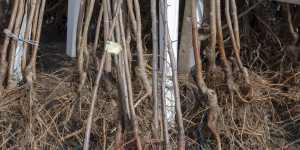But good news:this is also the best time to plant one,thanks to the bare root plant season moving into full swing this month.

Bare root plants have been dug up while dormant from the ground in which they were established,washed free of soil and sold with entirely naked roots.iStock
While nurseries started selling some bare root roses in April,the full array of bare root deciduous fruit trees,ornamental trees and shrubs,only appears in June. By mid-August,after which these plants resume active growth,they will be sold in soil in pots only,so its worth moving quickly to take advantage of what is a relatively brief window.
Thanks to how very economical a plant with neither soil nor pot can be,up to half the price of its potted counterpart,bare root plants are an especially affordable option for those establishing mass plantings.
They also offer environmental benefits due to being field grown (rather than relying on potting mix),lighter to transport and requiring less plastic. Plus you get more choice of cultivars,especially when it comes to fruit trees.
As their name suggests,bare root plants have been dug up while dormant from the ground in which they were established,washed free of soil and sold with entirely naked roots. Unpromising as they might appear,like a branching stick with roots,if you plant them right,they will adapt quickly to their new situation.
While they are commonly sold by mail order,some nurseries nestle their bare root stock into display beds of damp compost,leaving customers to slip out their chosen plants. The roots are then protected in a wad of moistened sawdust and wrapped,like a present,in paper and string.
But once you have your bare root plant home,there is little time to dally. Bare root plants should be planted as soon as possible,with their roots never allowed to dry out,which is why some nurseries opt to pot up their bare root stock before selling it. Bare root plants might be dormant,but they are not bulletproof.
Thanks to the fact that so many of the plants’ roots have been removed in the uprooting process,it’s essential to prune the branches to match. You need to ensure that the remaining roots can support the above-ground mass. Nurseries have different approaches to this. While some prune their stock before displaying it,others prune only at the point of purchase,which means your particular pruning needs,such as espaliering,can be accommodated. Others will leave it to the buyer to make their own cuts. If in doubt check before you buy.
While a bare-rooted plant can be kept in its sawdust padding,so long as it is kept damp,for several days,or transplanted into moistened compost for an even longer period,the sooner you plant your specimen the better. Ideally,have your ground prepared before you make your purchase and always soak your plant in a bucket of water for about 30 minutes before planting.
Choose a sunny spot with soil that is neither waterlogged in winter,nor excessively thin and lifeless in summer. Dig a wide and deep hole and add well-rotted compost,particularly to heavy or sandy soils. Compost can also be added to the ground around the hole,thereby improving the background fertility of your plot and encouraging the roots to grow out further.
Make sure your back-fill soil-and-compost mix is fine rather than clumpy and plant the tree to the same depth as the mark left from the soil in which it was planted in the ground. Tamp down the soil to ensure there is good contact with the roots and water. Continue to water frequently as the plant is establishing.
Finally,don’t despair if your plant is slow to develop leaves in spring. Some plants,such as walnuts,don’t green up until it’s almost summer. If you are worried about the health of your tree,an easy test is to lightly scrape a small spot on the trunk to see if the tissue below the bark is green and living.
While bare rooted trees can feel like a leap of faith,treat them right and they will unfurl into powerhouses of produce.
Make the most of your health,relationships,fitness and nutrition with our Live Well newsletter. every Monday.